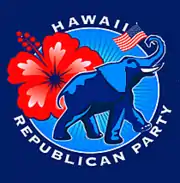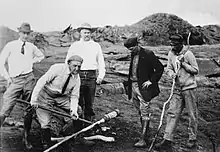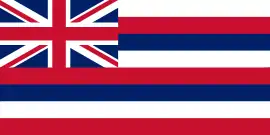Hawaii Republican Party
The Hawaii Republican Party is the affiliate of the Republican Party (GOP) in Hawaii, headquartered in Honolulu. The party was initially strong during Hawaii's territorial days, but following statehood the Democratic Party took control and is currently one of the weakest Republican affiliates along with the District of Columbia Republican Party.
Republican Party of Hawaii | |
|---|---|
 | |
| Chairperson | Vacant |
| Senate Minority Leader | Kurt Fevella |
| House Minority Leader | Vacant |
| Founded | May 2, 1900 |
| Merger of | Reform Party Home Rule Party |
| Headquarters | Honolulu |
| Ideology | Conservatism |
| Political position | Center-right |
| National affiliation | Republican Party |
| Colors | Red |
| State House | 4 / 51 |
| State Senate | 1 / 25 |
| Statewide Executive Offices | 0 / 2 |
| U.S. House of Representatives | 0 / 2 |
| U.S. Senate | 0 / 2 |
| Website | |
| gophawaii | |
History
Republic
Following the overthrow of the Hawaiian Kingdom and the creation of the Republic of Hawaii the American Union Party was created and as the Republic of Hawaii was a one-party state, it faced no opposition from opposing parties. On October 13, 1894 the American Union Party held its first convention to establish the party's organization, create a platform, and nominate candidates for the 1894 elections.[1] Although the party's official stance was in favor of annexation by the United States due to it being the only legal party there were anti-annexation factions within the party.
Territorial
After Hawaii was annexed by the United States and turned into a territory the majority of the American Union Party's members reformed and created the Hawaii Republican Party. On March 10, 1899 members of the American Union Party and former leaders of the Republic held a meeting where they decided to postpone the organization of a Republican Party and to not create an auxiliary party organization.[2] On May 2, 1900 around one hundred men organized the Republican party affiliate in Hawaii and on May 30, 1900 the first Hawaii Republican Convention was held where temporary officers were selected, created a platform, and selected delegates to send to the Republican national convention in June.[3][4]
In 1902 the Reform Party merged into the party and the Home Rule Party suffered a schism after Prince Jonah Kūhiō Kalanianaʻole left the party's convention on July 10 to temporarily form the Hui Kuokoa Party before joining the Republicans.[5] In the 1902 elections the Republicans successfully defeated Wilcox by running Kalanianaʻole, took control of the legislature with 26 of the 36 seats, and although the Home Rule Party would continue to exist in a weakened form until 1912. The Democratic Party of Hawaii was reorganized in 1902, but would not become influentially until the 1920s when it won multiple Honolulu mayoral elections and elected William Paul Jarrett as delegate to the House of Representatives.
Although there was a Democratic affiliate in the territory it held little influence with the Home Rule Party being the main opposition of the Republican party. The Home Rule Party took control of the territorial legislature and its leader, Robert William Wilcox, was elected as a delegate to the federal House of Representatives. However, the party remained in control and retook the delegation to the House in the 1930s and 1940s due to support from the Big Five sugar producers. However, the power of the Big Five was weakened by the National Labor Relations Act of 1935 which lead to unionization on Hawaii's sugar plantations that would lead to the Democratic Revolution in 1954.[6]
In the 1954 elections the party lost control of the territorial legislature for the first time since 1900 when the Democratic affiliate won nine of the fifteen territorial senate seats and twenty two of the thirty territorial house seats. The Democrats retained control of the legislature in the 1956 elections, but the Republicans retook control of the senate in the 1958 elections.
Statehood
On May 16, 1959 the affiliate held its first state convention where most of the officer positions went uncontested except for national committeewoman and where the candidates for the upcoming federal and state special elections.[7] In the gubernatorial election incumbent Territorial Governor William F. Quinn narrowly won by 4,139 votes, in the Senate special elections Hiram Fong narrowly won by 9,514 votes while Wilfred Tsukiyama was narrowly defeated by 4,577 votes, and lost the House election in a landslide.
During the 1998 gubernatorial election Maui Mayor Linda Lingle won the Republican nomination and used dissatisfaction with Governor Ben Cayetano's handling of the economy to propel her campaign and was shown to be polling above Cayetano in multiple polls. However, allegations of Lingle being a lesbian and her decision as mayor to not give state workers Christmas Eve hurt her. In the general election she was narrowly defeated by 5,254 votes, but she was the most successful Republican nominee for governor since Randolph Crossley in 1966.
In 1999 Lingle and many of her supporters took over leadership positions in the party with Lingle herself defeating James Kuroiwa Jr., who was aligned with the party's conservative wing and was pro-life, to become chairwoman with 325 to 63 votes.[8]
During the 2002 gubernatorial election the Democratic party had a contentious primary where Mazie Hirono defeated Ed Case by 2,000 votes and Hirono's campaign was later hurt by corruption allegations that allowed Linda Lingle to narrowly win the election becoming the first Republican governor since 1962. She later won reelection in 2006 becoming the only multi-term popularly elected Republican governor in the state's history.
During the 2004 presidential election multiple polls showed George W. Bush performing well in Hawaii and with recent gubernatorial victory the party made a push to win at least three seats to prevent Governor Lingle's vetoes from being overruled and possibly eleven seats in the state house to hold a one-seat majority of twenty six seats to the Democratic twenty five seats that would allow.[9] However, the Bush campaign later decreased its efforts in Hawaii and lost five seats in the House despite Bush winning 45.26% of the vote and being the closet the Republicans have come to winning the state in a presidential election since 1984.[10]
In 2010 Representative Neil Abercrombie resigned to focus on his gubernatorial campaign and a special election was held to fill the vacancy. Due to special elections not having primaries all of the candidates would run in a single race resulting in two Democrats splitting the vote allowing Charles Djou to win with a plurality of 39.68% of the vote and became the first Republican representative from Hawaii since Pat Saiki in 1991. However, he was narrowly defeated for reelection in the general election by Colleen Hanabusa.
Following Donald Trump's election as president the affiliate lost multiple members with Charles Djou becoming an independent and state House Minority Leader Beth Fukumoto becoming a Democrat.[11] On December 11, 2019 the party cancelled its presidential preference poll and committed all of its primary delegates to Trump.[12]
Political positions
Economics
As a whole, Hawaiʻi Republicans advocate for limited government, lower taxes, decentralized control of public schools, and improving the state's business climate.[13] Republicans have been supportive of big business plans and commitments to assist companies in the state in competing against large businesses in other states. They also usually support interstate and international commerce. For example, former Lieutenant Governor Duke Aiona has been a strong proponent of keeping the National Football League's Pro Bowl in Hawaii, and former Governor Linda Lingle proposed tax reduction incentives to businesses to encourage creation of work opportunities, such as hotel renovations.
Environment

In the Reform Party, a pre-statehood group that after annexation was largely sympathetic toward the Republican Party, Lorrin Thurston was a strong supporter of the formation of Hawaii Volcanoes National Park. In the 21st century, Governor Lingle proposed a Clean Energy Initiative to promote clean and renewable energy resources, with the goal of making the state 70% energy self-sustainable by 2030. The initiative plans to use solar, wind, ocean, geothermal, and biomass as energy resources with a phased reduction in the use of fossil fuels.
Religion
Despite the influence of the early missionaries and despite recent national trends, the Republican party in Hawaiʻi steadily lost its Christian overtone over time. After annexation, Christians proselytized to new, incoming immigrants contracted to work on Hawaii's growing sugar industry. This was, in large part, brought on by Farrington v. Tokushige (1927), a Supreme Court case brought by approximately 100 Japanese, Korean, and Chinese language schools, a number of which were also Buddhist religious schools, against Republican Governor Wallace R. Farrington and the Republican government for passing laws limiting the material taught in private schools, including Buddhist philosophy.[14] The court found the laws unconstitutional and in violation of parents' Fifth Amendment right to choose the education of their children.[15][16] Duke Aiona, a Republican, presented a proclamation to the president of the Junior Young Buddhist Association in 2004[17] and attended the 2010 lantern festival.[18]
Recently, the Party has been hesitant to associate itself with religion in general, with members citing the negative effects of the party's association with the Hawaii branch of the Christian Coalition formed by Pat Robertson in 1988. The Coalition swelled Republican membership by 50%, but also gave rise to infighting; by 1993 the party had lost more legislative seats than it started with.[19]
Staff
| Name | Position |
|---|---|
| Vacant | State Chairman |
| Vacant | Executive Director |
County Chairs
| Name | County |
|---|---|
| Jeffrey Coakley | West Hawaii |
| Lani Eugenio | East Hawaii |
| Steve Yoder | Kauai |
| Gregg Lussier | Maui |
| Brett Kulbis | Honolulu |
Elected officials
Congress
- Hiram Fong, United States Senator (1959-1977)
- Charles Djou, United States Representative from Hawaii's 1st district (2010-2011)
- Pat Saiki, United States Representative from Hawaii's 1st district (1987-1991)
- Mary Elizabeth Pruett Farrington, Delegate to the United States House from Hawaii Territory's at-large district (1954-1957)
- Joseph Rider Farrington, Delegate to the United States House from Hawaii Territory's at-large district (1943-1954)
- Samuel Wilder King, Delegate to the United States House from Hawaii Territory's at-large district (1935-1943)
- Victor S. K. Houston, Delegate to the United States House from Hawaii Territory's at-large district (1927-1933)
- Henry Alexander Baldwin, Delegate to the United States House from Hawaii Territory's at-large district (1922-1923)
- Jonah Kūhiō Kalanianaʻole, Delegate to the United States House from Hawaii Territory's at-large district (1903-1922)
State Officials
- Linda Lingle, Governor of Hawaii (2002-2010)
- Duke Aiona, Lieutenant Governor of Hawaii (2002-2010)
- William F. Quinn, Governor of Hawaii (1957-1962)
- James Kealoha, Lieutenant Governor of Hawaii (1959-1962)
- Samuel Wilder King, Territorial Governor of Hawaii (1953-1957)
- Lawrence M. Judd, Territorial Governor of Hawaii (1929-1934)
- Wallace Rider Farrington, Territorial Governor of Hawaii (1921-1929)
- Walter F. Frear, Territorial Governor of Hawaii (1907-1913)
- George R. Carter, Territorial Governor of Hawaii (1903-1907)
- Sanford B. Dole, Territorial Governor of Hawaii (1900-1903)
State Legislative Leaders
Electoral performance
Congressional
|
|
State legislature
|
|
References
- "The Convention". The Hawaiian Star. 15 October 1894. p. 3. Archived from the original on 29 December 2019 – via Newspapers.com.
- "Confound Their Politics". The Hawaiian Star. 10 March 1899. p. 1. Archived from the original on 29 December 2019 – via Newspapers.com.
- "GOP Has Been Hawaii's Party Of The People". The Honolulu Advertiser. 13 June 1954. p. 52. Archived from the original on 30 December 2019 – via Newspapers.com.
- "Republican Convention". Evening Bulletin. 2 June 1900. p. 10. Archived from the original on 29 December 2019 – via Newspapers.com.
- "Cupid Leaves The Convention". The Hawaiian Star. 11 June 1902. p. 10. Archived from the original on 29 December 2019 – via Newspapers.com.
- "Chairman Traces History of Demo Party In Hawaii". Hawaii Tribune-Herald. 27 October 1971. p. 4. Archived from the original on 31 December 2019 – via Newspapers.com.
- "Woolaway Heads Island G.O.P.; 700 at Harmonious Convention". The Honolulu Advertiser. 18 May 1959. p. 15. Archived from the original on 30 December 2019 – via Newspapers.com.
- "Lingle, backers take control of GOP". Honolulu Star-Bulletin. 24 May 1999. p. 37. Archived from the original on 29 December 2019 – via Newspapers.com.
- "Republicans gunning for state House control". Honolulu Star-Bulletin. 4 June 2004. p. 9. Archived from the original on 29 December 2019 – via Newspapers.com.
- "No Republican revolution in Hawaii". Hawaii Tribune-Herald. 4 November 2004. p. 3. Archived from the original on 29 December 2019 – via Newspapers.com.
- "The Republican Party is almost extinct in Hawaii – and it's only getting worse". Journal and Courier. 12 November 2017. Archived from the original on 29 December 2019 – via Newspapers.com.
- "Hawaii GOP cancels presidential preference poll, commits delegates to Trump". The Hill. 12 December 2019. Archived from the original on 29 December 2019 – via Newspapers.com.
- Hawaii Republican Party staff (2007-07-04). "About". Hawaii Republican Party. Retrieved 2007-07-04.
- Encyclopedia of women and religion in North America, Volume 2 by Rosemary Skinner Keller p.681
- A digest of Supreme Court decisions affecting education, Fourth edition by Perry Alan Zirkel p.135
- The Japanese in Hawaii by Roland Kotani p.62-65
- Lt. Governor's E-newsletter July 7, 2004
- "Hawaii Floating Lantern Ceremony Inspires Awe" by Gordon Y.K. Pang, Honolulu Advertiser
- "Local GOP poised for mix of religion into politics", Honolulu Star-Bulletin, April 22, 2009.
Bibliography
- Andrade Jr., Ernest (1996). Unconquerable Rebel: Robert W. Wilcox and Hawaiian Politics, 1880–1903. University Press of Colorado. ISBN 0-87081-417-6.
- Chapin, Helen Geracimos (1996). Shaping history: the role of newspapers in Hawai'i. Shaping history: the role of newspapers in Hawai'i.
- Kame'eleihiwa, Lilikala (1995). A synopsis of Traditional Hawaiian Culture, the Events Leading to the 1887 Bayonet Constitution and the Overthrow of the Hawaiian Government. (unpublished).
- Laenui, Poka (1984). East Wind, Vol. III, No. 1. East Wind, Vol. III, No. 1.
- Liliuokalani (1898). Hawaii's Story. Tothrop, Lee & Shepard Co.
